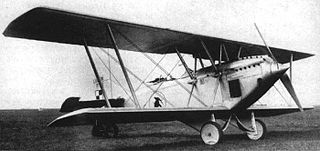
The Lublin R-VIII was a Polish bomber, reconnaissance aircraft and seaplane designed in the late 1920s by the Plage i Laśkiewicz factory in Lublin. It was the first in-house design of Plage i Laśkiewicz, and the first with the name Lublin.
The Letov Š-16 was a Czechoslovak single-engined, two-seat biplane bomber. It was designed by Alois Šmolík at Letov Kbely. The Š-16 first flew in 1926.

The Blériot 127 was a French bomber aircraft of the 1920s and 1930s, developed from the Blériot 117 escort fighter. It was a large monoplane of conventional configuration that featured open gunner's positions in its nose and at the rear of its two underwing engine nacelles. The wing airfoil was of sufficient thickness that these latter positions could be accessed from the fuselage in flight.

The Fokker C.I was a German reconnaissance biplane under development at the end of World War I. The design was essentially an enlarged Fokker D.VII fighter with two seats and a 138 kW (185 hp) BMW IIIa engine. The C.I was originally developed to sell to the German Army. It never saw service in World War I, but Anthony Fokker managed to smuggle parts out of Germany at the time of the Armistice.

The Breda A.4 was a biplane trainer produced in Italy in the mid-1920s. It was of conventional configuration with a two-bay unstaggered wing cellule and seating for the pilot and instructor in tandem open cockpits. Apart from civil use, the A.4 was also adopted by the Regia Aeronautica as a trainer. At least some examples were produced in floatplane configuration as the A.4idro.

The Breguet 27 was a 1930s French biplane military reconnaissance aircraft, built for the Armée de l'Air and for export to Venezuela and China.

The Fokker C.VII-W was a reconnaissance seaplane built in the Netherlands in the late 1920s. Sharing elements of the highly successful C.V design, the C.VII-W was a conventional, single-bay biplane with wings of unequal span braced with N-struts. The undercarriage consisted of a standard twin-pontoon arrangement, and the fin and rudder continued through to the ventral side of the fuselage, creating a cruciform tail. The pilot and observer sat in tandem, open cockpits. The wing structure was wooden with fabric and plywood covering, and the fuselage was of steel tube construction with fabric covering.
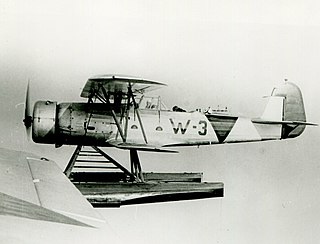
The Fokker C.XI-W was a reconnaissance seaplane designed to operate from warships that was produced in the Netherlands in the mid-1930s. It was the result of a Royal Netherlands Navy specification of 1935 requesting such an aircraft. Fokker's response was a conventional single-bay biplane with staggered wings of unequal span braced by N-struts. The pilot and observer sat in tandem, open cockpits, and the undercarriage consisted of twin pontoons. The wings were of wooden construction with plywood and fabric covering, and the fuselage was of steel tube, also covered with fabric.
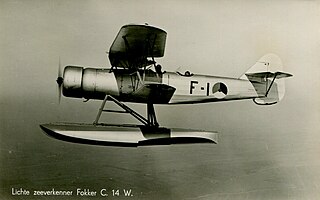
The Fokker CXIV-W was a reconnaissance seaplane produced in the Netherlands in the 1930s. It was a conventional, single-bay biplane with staggered wings of unequal span braced by N-struts. The pilot and observer sat in tandem, open cockpits, and the undercarriage consisted of twin pontoons. 11 of the 24 examples produced were stationed in the Dutch East Indies. These were later joined by 12 aircraft that had escaped to the UK following the German invasion of the Netherlands in 1940. All C.XIVs were destroyed during the Japanese invasion of the Dutch East Indies.
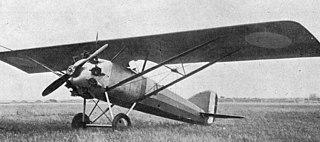
The Gourdou-Leseurre GL.30 was a racing aircraft built in France in 1920 which formed the basis for a highly successful family of fighter aircraft based on the same design.
The Renard Epervier was a Belgian prototype single-seat all-metal fighter monoplane designed by Alfred Renard at the Societé Anonyme Avions et Moteurs Renard for a government-sponsored design contest in 1928. The Epervier Type 2 was built and flown in 1928, by Belgian aircraft manufacturer Stampe et Vertongen. It carried an armament of two synchronised 7.7mm guns and was lost in September 1928 after failing to recover from a flat spin. A second prototype, the Epervier Type 2bis, introduced revised streamlined fairings for the cantilever mainwheel legs, mainwheel spats and cylinder aft-fairings and was built by SABCA.

The Levasseur PL.5 was a carrier-based fighter produced in France in the late 1920s, in response to the 1924 AMBC.2 specification issued by the Service Technique de l'Aéronautique (STAé). It was a conventional, single-bay sesquiplane that carried a crew of two in tandem, open cockpits. Like other Levasseur naval designs of the day, it incorporated several safety features in case of ditching at sea. Apart from small floats attached directly to the undersides of the lower wing, the main units of the fixed, tail-skid undercarriage could be jettisoned in flight, and the underside of the fuselage was given a boat-like shape and made watertight.

The Levasseur PL.10 was a carrier-based reconnaissance aircraft developed in France in the late 1920s. It was a conventional, single-bay biplane along similar lines to Levasseur's contemporary designs for the French navy, including a watertight, boat-shaped fuselage, small underwing floats, and undercarriage that could be jettisoned in flight in order to improve the changes of a successful ditching.
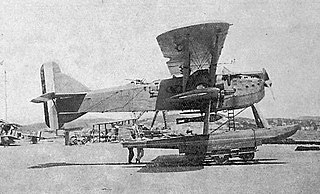
The Levasseur PL.14 was a torpedo bomber seaplane developed in France in the late 1920s. It was essentially similar to Levasseur's PL.7 carrier-based reconnaissance aircraft with the addition of pontoons. The design dispensed with the small underwing floats that formed part of the safety equipment of Levasseur's carrier-based aircraft of the period, but retained the boat-like fuselage. The wing was built to the 18.00-metre design originally developed for the PL.7 but ultimately rejected in favour of a shorter wing.
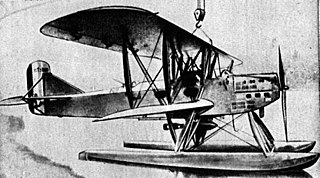
The Levasseur PL.15 was a torpedo bomber seaplane developed in France in the early 1930s. It was a follow-on design to Levasseur's PL.14 that had, in turn, been developed from the carrier-based PL.7. While the PL.14 retained the PL.7's boat-like fuselage, the PL.15 was a purpose-built seaplane with an all-new, slender fuselage.
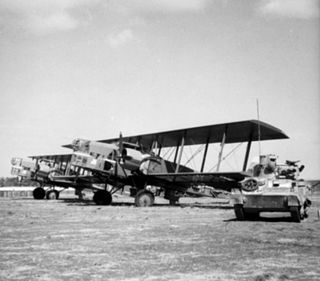
The Lioré et Olivier LeO 25 was a bomber aircraft produced in France in the late 1920s.

The Latécoère 490 was a two-seat, single-engined parasol winged aircraft, designed to a French photographic reconnaissance specification of 1928. Only two prototypes were built.

The Romano R.90 was a prototype single-seat French floatplane fighter of the 1930s. A single example of the R.90 was built, but the type did form the basis of the Romano R.83 and Romano R.92 fighters which were built in secret for the Spanish Republicans during the Spanish Civil War.

The Levy Biche LB.2 was a single seat French sesquiplane fighter aircraft designed to be used from aircraft carriers. With a watertight fuselage, jettisonable wheeled undercarriage and small under-wing floats, it could survive emergency sea touchdowns; it could also be fitted with seaplane type floats.

The Les Mureaux 3 C.2 and Les Mureaux 4 C.2 were French two seat, parasol winged fighters, flown in 1927-8, which differed only in their engines. They were developed into near identical army co-operation types, the ANF Les Mureaux 130 A.2 and ANF Les Mureaux 131 A.2, in 1929–31.




















